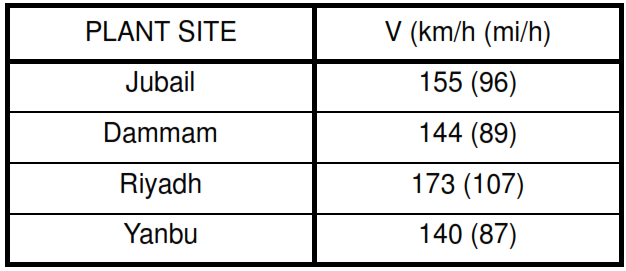All tables and methods of calculation contained in this article for determining wind loads to be applied to buildings and other structures are in accordance with ASCE 7-95 and as noted herein. Structures sensitive to wind, for example tall buildings with a height-to-width ratio greater than 5, stacks, and process columns shall be analyzed in accordance with ASCE 7-95 (methods specified in Table 6-1 and paragraph 6.6 of the commentary), or by a consultant recognized as being knowledgeable in this field. A rational analysis that incorporates the dynamic properties of the main wind-force resisting system is often needed to determine the response of these structures to the wind.
The following are changes to ASCE 7-95 with respect to ASCE 7-93.
a. Revised wind speed (V) based on 3-second gust speed.
b. Revised velocity pressure (qz) formulation.
c. Revised velocity pressure exposure coefficient (Kz). Revised gust response factor (G). Revised importance factor (I).
f. Revised classification categories of buildings and other structures.
There is a possibility that provisions of ASCE 7-95 can be implemented through out U.S.A. by the year 2000, if an agreement can be reached by the three model codes (ICBO, BOCA, and SBCCI) on a common National Code. Until then, flexibility in selecting wind loads exists for consideration when a design needs to be optimized. Appropriate provisions for design optimization shall be selected by the responsible design engineer according to project requirements.
Wind Load on Structures General Notes
Wind shall be assumed to come from any horizontal direction. No reduction in wind pressure shall be taken for the shielding effect of adjacent structures.
The basic wind velocities (V) for plants are listed in Table I. The V values are taken from ’Extreme Wind Speeds in Kingdom of Saudi Arabia based on the new ASCE 7-95 Standard’, project sponsored by King Abdul Aziz City for Science and Technology, research paper presented in the 5th Saudi Engineering Conference. The values are taken at 10 m (33 ft) above ground level. The plant site exposure category is C with a mean recurrence interval of 50 years (annual probability 0.02).
Tabl e I – Basic Wind Velocities
The basic wind velocities of Table I have been converted to velocity pressures (Tables VI, VIa, VII and VIIa) by applying ASCE 7-95 formulas for the following categories: (Any change in latest revision of ASCE 7 will be applicable here also)
Exposure C: Open terrain with scattered obstruction having heights generally less than 9.1 m (30 ft), flat open country, and grasslands.
Exposure D: Flat, unobstructed areas exposed to wind flowing over open water for a distance of at least 1.61 km (1 mi.). This exposure shall apply only to those buildings and other structures exposed to wind coming from over the water. Exposure D extends inland from the shoreline a distance of 460 m (1,500 ft) or 10 times the height of the building or structure, whichever is greater.
It determines the building classification for the building being designed. Building classifications (Categories I to IV) are defined in Table II (ASCE 7-95 Table 1-1). Importance Factor ’I’ varies with building categories as shown in Table III (ASCE 7-95, Table 6-2).
4.5.1 Importance Factor I- This factor is used to adjust the level of structural reliability of a building or other structures to be consistent with the building classifications. An importance factor of 1.00 for Category II structures (all buildings and other structures except those listed in Categories I, III and IV) is used in this standard. This ’I’ value is also associated with an annual probability of 0.04 of being exceeded (with a mean recurrence interval of 25 years) and is applicable to SABIC plants in Saudi Arabia.
The wind load conversion factors of Table IV shall be used when determining wind load.
Tabl e II (ASCE 7-95 Table 1-1) – Classification of Buildings and Other Structures for Wind, Snow, and Earthquake Loads
| NATURE OF OCCUPANCY | CATEGORY |
| Buildings and other structures that represent a low hazard to human life in the event of failure, for example: (i) agricultural facilities (ii) certain temporary facilities (iii) Minor storage facilities |
I |
| All buildings and other structures except those listed in Categories I, III, and IV | II |
| Buildings and other structures that represent a substantial hazard to human life in the event of failure, for example: (i) Buildings and other structures where more than 300 people congregate in one area (ii) Buildings and other structures with elementary school, secondary school, or day-care facilities with capacity greater than 250 (iii) Buildings and other structures with a capacity greater than 500 for colleges or adult education facilities (iv) Health-care facilities with a capacity of 50 or more resident patients but not having surgery or emergency treatment facilities (v) Jails and detention facilities (vi) Power generating stations and other public utility facilities not included in Category IV (vii) Buildings and other structures containing sufficient quantities or toxic or explosive substances to be dangerous to the public if released. |
III |
| Buildings and other structures designated as essential facilities, for example: (i) Hospitals and other health-care facilities having surgery or emergency treatment facilities. (ii) Fire, rescue, and police stations and emergency vehicle garages . (iii) Designated earthquake, hurricane, or other emergency shelters. (iv) Communications centers and other facilities required for emergency response. (v) Power generating stations and other public utility facilities required in an emergency. (vi) Buildings and other structures having critical national defense functions. |
IV |
Tabl e III (ASCE 7-95 Table 6-2) – Importance Factor, I (Wind Loads)

Note: 1. The building and structure classification categories are listed in Table II.
Table IV – Wind Load Conversion

